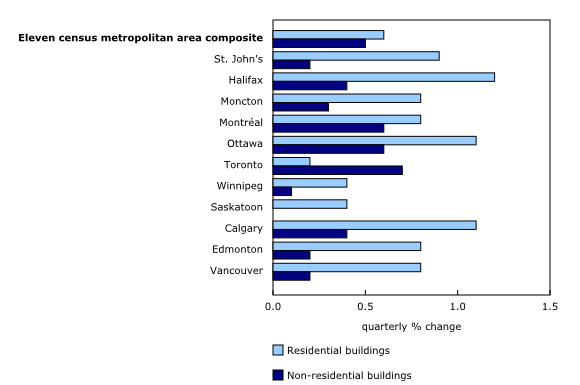Building construction price indexes, first quarter 2020
Archived Content
Information identified as archived is provided for reference, research or recordkeeping purposes. It is not subject to the Government of Canada Web Standards and has not been altered or updated since it was archived. Please "contact us" to request a format other than those available.
Released: 2020-04-29
Prices for residential building construction increased 0.6% in the first quarter, while the cost of non-residential building construction rose 0.5%.
Impact of COVID-19 on building construction prices in the first quarter
As the collection period for this survey ended on March 20, the impact of COVID-19 on building construction prices was only partly captured in the first quarter data. All provinces except Quebec included construction in their list of essential services. As of March 25, Quebec limited essential services to emergency repairs, equipment rental and landscaping services. Worksites were able to remain operational for the most part, while following physical distancing and enhanced health and safety guidelines.
Existing and anticipated supply chain disruptions resulted in slower receipt of construction materials. Availability of skilled trades began to be affected by illness or people choosing not to work for health and safety reasons. The impact of this supply cost driver was mitigated by an anticipated decrease in demand in the non-essential sectors of construction and slower receipt of construction materials. These factors will continue to affect construction costs well into the second quarter. In addition, delays in construction projects are anticipated as a result of the partial or full closure of government facilities responsible for approving and issuing permits.
Construction costs rise for all building types from the fourth quarter of 2019 to the first quarter of 2020
At the national level, construction costs during the first quarter were up for all types of residential and non-residential buildings included in the survey, with increases ranging from 0.4% to 0.7%. Among residential buildings, the largest quarterly price increase was for low-rise apartment buildings (+0.7%). For non-residential buildings, construction costs rose the most for bus depots (+0.6%).
On the residential side, building construction costs increased the most in Halifax (+1.2%), followed by Calgary and Ottawa (both up 1.1%). On the non-residential side, it cost more to build in Toronto (+0.7%), Ottawa and Montréal (both up 0.6%). Higher industry-wide insurance rates were reported by both residential and non-residential builders across the country.
Construction costs increase the most in Ottawa, Montréal and Toronto on a year-over-year basis
Increases in construction costs for residential (+2.2%) and non-residential (+1.8%) buildings slowed over the 12-month period ending in the first quarter, compared with 2.3% and 2.2% rises in construction costs in the fourth quarter of 2019.
On an annual basis, construction costs for residential buildings rose the most in Ottawa (+3.6%) and Montréal (+3.1%).
In Ottawa, construction costs for all residential building types have been increasing steadily since the beginning of this index series in 2017. However, since the first quarter of 2018, construction costs for high-rise apartment buildings have been increasing at a slower pace than those for other building types.
For non-residential buildings, the largest year-over-year price increases were in Montréal (+3.4%), followed by Toronto (+2.9%).
Note to readers
The building construction price indexes are quarterly series that measure change over time in the prices that contractors charge to construct a range of new commercial, institutional, industrial and residential buildings in 11 census metropolitan areas: St. John's, Halifax, Moncton, Montréal, Ottawa–Gatineau (Ontario part), Toronto, Winnipeg, Saskatoon, Calgary, Edmonton and Vancouver.
These buildings include six non-residential structures: an office building, a warehouse, a shopping centre, a factory, a school, and a bus depot with maintenance and repair facilities. In addition, indexes are produced for five residential structures: a bungalow, a two-storey house, a townhouse, a high-rise apartment building (five storeys or more) and a low-rise apartment building (fewer than five storeys).
The contractor's price reflects the value of all materials, labour, equipment, overhead and profit to construct a new building. It excludes value added taxes and real estate fees and any costs for land, land assembly, building design and land development.
With each release, data for the previous quarter may have been revised. The index is not seasonally adjusted.
Products
Statistics Canada has launched the Producer Price Indexes Portal as part of a suite of portals for prices and price indexes. This web page provides Canadians with a single point of access to a wide variety of statistics and measures related to producer prices.
The video "Producer Price Indexes" is available on the Statistics Canada Training Institute web page. It provides an introduction to Statistics Canada's producer price indexes—what they are, how they are made and what they are used for.
Contact information
For more information, or to enquire about the concepts, methods or data quality of this release, contact us (toll-free 1-800-263-1136; 514-283-8300; STATCAN.infostats-infostats.STATCAN@canada.ca) or Media Relations (613-951-4636; STATCAN.mediahotline-ligneinfomedias.STATCAN@canada.ca).
- Date modified:



